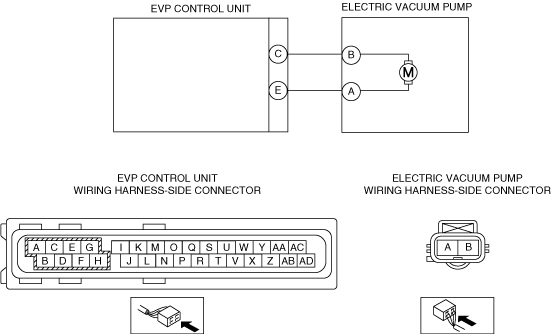|
1
|
RECORD SNAPSHOT DATA AND DIAGNOSTIC MONITORING TEST RESULTS TO UTILIZE WITH REPEATABILITY VERIFICATION
-
Note
-
• Recording can be facilitated using the screen capture function of the PC.
• Record the snapshot data and DIAGNOSTIC MONITORING TEST RESULTS (fuel system related) on the repair order.
|
—
|
Go to the next step.
|
|
2
|
VERIFY IF DIAGNOSTIC RESULT IS AFFECTED BY OTHER RELATED DTCs OCCURRING
• Using the M-MDS, perform the EVP control unit DTC inspection.
• Is any other DTC or pending code stored?
|
Yes
|
Go to the applicable DTC inspection.
|
|
No
|
Go to the next step.
|
|
3
|
DETERMINE IF VACUUM LINE MALFUNCTION
• Switch the ignition ON (engine off).
• Access the following EVP control unit PIDs using the M-MDS:
-
― VPR1_V
― VPR2_V
― VS1
― VS2
• Are VPR_1 and VPR_2 both ON, and are VS1 and VS2 both 23.3 kPa {175 mmHg, 6.89 inHg} or more on the snap shot data?
|
Yes
|
Inspect for leakage in vacuum line.
Repair or replace the malfunctioning part, then go to Step 8.
|
|
No
|
Go to the next step.
|
|
4
|
DETERMINE IF ELECTRIC VACUUM PUMP MALFUNCTION
• Switch the ignition ON (engine off).
• Access the following EVP control unit PIDs using the M-MDS:
-
― VP_MV
― VP_PV
― VP_C
• Verify PID value based on the service questions content and snap shot data driving conditions.
• Are PID values within specification?
Specification:
• When the electric vacuum pump is operated:
-
VP_MV: Below 0.8 V
VP_PV: 8.0—17.4 V
VP_C: 0—15 A
• When the electric vacuum pump is stopped:
-
VP_MV: 4.1—8.7 V
VP_PV: 4.1—8.7 V
VP_C: Approx. 0 A
|
Yes
|
Go to the next step.
|
|
No
|
Inspect for short to ground in the electric vacuum pump internal circuit.
If there is a malfunction in electric vacuum pump internal circuit:
• Replace the electric vacuum pump, then go to Step 8.
If there is not malfunction in electric vacuum pump internal circuit:
• Go to the next step.
|
|
5
|
INSPECT ELECTRIC VACUUM PUMP CIRCUIT FOR SHORT TO GROUND CIRCUIT
• Switch the ignition OFF.
• Disconnect the negative battery cable.
• Disconnect the electric vacuum pump connector.
• Inspect for continuity between electric vacuum pump terminal A (wiring harness-side) and body ground.
• Is there continuity?
|
Yes
|
Disconnect the EVP control unit connector and inspect the wiring harness for short to ground.
• If the short to ground circuit could be detected in the wiring harness:
-
― Refer to the wiring diagram and verify whether or not there is a common connector between electric vacuum pump terminal A and EVP control unit terminal E.
If there is a common connector:
-
• Determine the malfunctioning part by inspecting the common connector and the terminal for corrosion, damage, or pin disconnection, and the common wiring harness for a short to ground circuit.
• Repair or replace the malfunctioning part.
If there is no common connector:
-
• Repair or replace the wiring harness which has a short to ground circuit.
• If the short to ground circuit could not be detected in the wiring harness:
-
― Replace the EVP control unit. (short to ground in the EVP control unit internal circuit)
Go to Step 8.
|
|
No
|
Go to the next step.
|
|
6
|
DRIVE VEHICLE THEN VERIFY DTC REPEATABILITY BASED ON SERVICE QUESTIONING RESULTS AND SNAP SHOT DATA
• Switch the ignition ON (engine off).
• Access the following EVP control unit PIDs using the M-MDS:
-
― VPS_FBK
― VP_MV
― VP_PV
― VP_C
― VPR1_V
― VPR2_V
― VS1
― VS2
• Verify PID value based on the service questions content and snap shot data driving conditions.
• Are PID values within specification?
-
Specification:
When the electric vacuum pump is operated (VPS_FBK PID value is On):
-
VP_MV: below 0.8 V
VP_PV: 8.0—17.4 V
VP_C: 0—15 A
VPR1_V, VPR2_V: On
VS1, VS2: below 40 kPa {300 mmHg, 11 inHg}
When the electric vacuum pump is stopped (VPS_FBK PID value is Off):
-
VP_MV: 4.1—8.7 V
VP_PV: 4.1—8.7 V
VP_C: Approx.0 A
VPR1_V, VPR2_V: Off
VS1, VS2: 23.3 kPa {175 mmHg, 6.89 inHg} or more
|
Yes
|
Go to the next step.
|
|
No
|
Inspect related components and harnesses.
Repair or replace the malfunctioning part, then go to Step 8.
|
|
7
|
VERIFY DTC REPEATABILITY AND DETERMINE IF MALFUNCTION CAUSE IS EVP CONTROL UNIT
• Using the M-MDS, clear the DTC from the EVP control unit.
• Switch the ignition ON (engine off).
• Using the M-MDS, perform the EVP control unit DTC inspection.
• Is the same DTC present?
|
Yes
|
Replace the EVP control unit, then go to Step 9.
|
|
No
|
DTC troubleshooting completed.
Explain to the customer that there are no malfunctions with the vehicle based on the contents of the servicing.
|
|
8
|
VERIFY DTC TROUBLESHOOTING COMPLETED
• Using the M-MDS, clear the DTC from the EVP control unit.
• Using the M-MDS, perform the EVP control unit DTC inspection.
• Is the same DTC present?
|
Yes
|
Repeat the inspection from Step1.
If the malfunction recurs, replace the EVP control unit, then go to the next step.
|
|
No
|
Go to the next step.
|
|
9
|
VERIFY NO DTC IS PRESENT
• Are any DTCs present?
|
Yes
|
Go to the applicable DTC inspection.
|
|
No
|
DTC troubleshooting completed.
|
